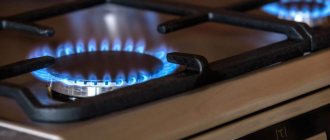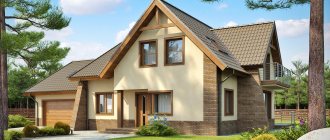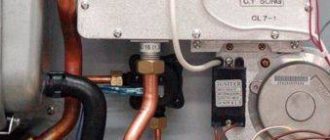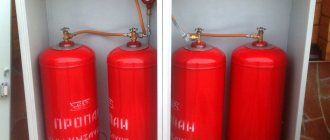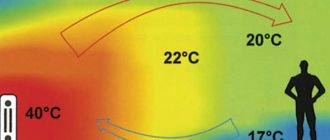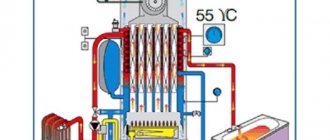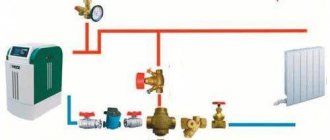When choosing boiler equipment for a heating system, a very disturbing thought persistently drills into your head - how voracious will the unit be? Surely the answer will appear when the heating starts working and the meter begins to count the gas consumption of the floor-standing boiler, regularly accelerating. However, it will be too late to lament if the amounts payable for gas are not satisfactory...
Competent sales consultants, of course, answer most of the questions that arise; you can always turn to a competent engineer for help, but it’s a good idea to have at least basic knowledge yourself.
Learn from this article as much as possible about the methods for calculating energy consumption and the factors that must be taken into account in the calculations. Below you will find not only boring formulas, but also examples. Finally, we talk about what can be done to reduce gas consumption.
What affects gas consumption?
Fuel consumption is determined, firstly, by power - the more powerful the boiler, the more intensively gas is consumed. At the same time, it is difficult to influence this dependence from the outside.
Even if you turn down a 20-kilowatt device to minimum, it will still consume more fuel than its less powerful 10-kilowatt counterpart turned on at maximum.
This table shows the relationship between the heated area and the power of the gas boiler. The more powerful the boiler, the more expensive it is. But the larger the area of the heated premises, the faster the boiler pays for itself
Secondly, we take into account the type of boiler and the principle of its operation:
- open or closed combustion chamber;
- convection or condensation;
- regular chimney or coaxial;
- one circuit or two circuits;
- the presence of automatic sensors.
In a closed chamber, fuel is burned more economically than in an open chamber. The efficiency of the condensing unit, thanks to the built-in additional heat exchanger for condensing the vapors present in the combustion product, increases to 98-100% compared to 90-92% efficiency of the convection unit.
With a coaxial chimney, the efficiency value also increases - cold air from the street is heated by a heated exhaust pipe. Due to the second circuit, of course, there is an increase in gas consumption, but in this case the gas boiler also serves not one, but two systems - heating and hot water supply.
Automatic sensors are a useful thing; they detect the external temperature and adjust the boiler to the optimal mode.
Thirdly, we look at the technical condition of the equipment and the quality of the gas itself. Scale and scale on the walls of the heat exchanger significantly reduce heat transfer; its deficiency must be compensated by increasing power.
Alas, gas can also contain water and other impurities, but instead of making claims to suppliers, we switch the power regulator a few notches towards the maximum level.
One of the modern highly economical models is a floor-standing gas condensing boiler of the Baxi Power brand with a power of 160 kW. Such a boiler heats 1600 sq. m of area, i.e. a large house with several floors. At the same time, according to the passport data, it consumes 16.35 cubic meters of natural gas. m per hour and has an efficiency of 108%
And, fourthly, the area of heated premises, natural heat loss, duration of the heating season, weather conditions. The more spacious the area, the higher the ceilings, the more floors, the more fuel will be required to heat such a room.
We take into account some heat leakage through windows, doors, walls, and roof. It doesn’t change from year to year, there are warm winters and bitter frosts - you can’t predict the weather, but the cubic meters of gas spent on heating directly depend on it.
Natural gas consumption at home
The owners of all apartments and houses and many enterprises need to calculate the volume of gas consumed. Data on the need for fuel resources is included in the designs of individual houses and their parts. To pay according to actual figures, gas meters are used.
The level of consumption depends on the equipment, the thermal insulation of the building, and the time of year. In apartments without centralized heating and hot water supply, the load goes to the water heating boiler. The device consumes up to 3-8 times more gas than a stove.
Gas water heaters (boilers, boilers) are wall-mounted and floor-mounted: they are used simultaneously for heating and water heating, and less functional models are mainly used only for heating
The maximum consumption of the stove depends on the number of burners and the power of each of them:
- reduced - less than 0.6 kW;
- regular - about 1.7 kW;
- increased - more than 2.6 kW.
According to another classification, low power burners correspond to 0.21-1.05 kW, normal - 1.05-2.09, high - 2.09-3.14, and high - more than 3.14 kW.
A typical modern stove uses at least 40 liters of gas per hour when switched on. Typically, a stove consumes about 4 m³ per month per resident, and the consumer will see approximately the same figure if they use a meter. In terms of volume, much less compressed gas in cylinders is required. For a family of 3 people, a 50 liter container will last about 3 months.
In an apartment with a 4-burner stove and no water heater, you can install a counter marked G1.6. A device with standard size G2.5 is used if there is also a boiler. To measure gas flow, large gas meters are also installed, on G4, G6, G10 and G16. A meter with parameter G4 can handle the calculation of gas consumption by 2 stoves.
Water heaters are 1- and 2-circuit. For a boiler with 2 branches and a powerful gas stove, it makes sense to install 2 meters. One reason is that household gas meters do not cope well with large differences between the power of the equipment. A weak stove at minimum speed uses many times less fuel than a water heater at maximum.
A classic stove has 1 large burner, 2 medium and 1 small; using the largest one is the most economical.
Subscribers without meters pay for volume based on consumption per 1 inhabitant multiplied by their number, and consumption per 1 m² multiplied by the heated area. The standards are valid all year round - they contain an average indicator for different periods.
Norm for 1 person:
- Gas consumption for cooking and heating water using a stove in the presence of a centralized hot water supply (DHW) and central heating is about 10 m³/month per person.
- Using a stove alone without a boiler, centralized hot water supply and heating is approximately 11 m³/month per person.
- Using a stove and water heater without central heating and hot water supply is about 23 m³/month per person.
- Heating water with a water heater is about 13 m³/month per person.
In different regions, the exact flow parameters do not coincide. Individual heating using a water heater costs approximately 7 m³/m² for heated residential premises and about 26 m³/m² for technical ones.
On the notice from the meter installation company you can see how different the consumption indicators are with and without a gas meter
The dependence on gas consumption is indicated in SNiP 2.04.08-87. The proportions and indicators are different there:
- stove, central hot water supply - 660 thousand kcal per person per year;
- there is a stove, no hot water supply - 1100 thousand kcal per person per year;
- there is a stove, a water heater and no hot water - 1900 thousand kcal per person per year.
Consumption according to the standards is influenced by the area, the number of residents, the level of amenities with household communications, the presence of livestock and its number.
The parameters are differentiated based on the year of construction (before 1985 and after), the use of energy-saving measures, including insulation of facades and other external walls.
You can read more about gas consumption standards per person in this material.
Quick estimate
It is quite simple to estimate by eye how much gas will be consumed by your gas boiler.
We will start from either the volume of the heated room or its area:
- in the first case, we use the standard 30-40 W/cubic meter. m;
- in the second case - 100 W/sq. m.
The standards are taken taking into account the ceiling height in the room up to 3 meters. If you live in the southern regions, the numbers can be reduced by 20-25%, and for the north, on the contrary, they can be increased by one and a half times or doubled. Those. take in the second case, for example, 75-80 W/sq.m or 200 W/sq.m.
By multiplying the corresponding standard by the volume or area, we get how many watts of boiler power are needed to heat the room. Next, we proceed from the standard statement that modern gas equipment consumes 0.112 cubic meters of gas to generate 1 kW of thermal power.
We multiply again - this time the gas consumption standard (number 0.112) by the boiler power obtained in the previous multiplication (do not forget to convert watts to kW). We get the approximate gas consumption per hour.
The boiler usually works 15-16 hours a day. We calculate the daily gas consumption. Well, when the daily consumption is already known, we can easily determine the gas consumption for the month and for the entire heating season. The calculations are approximate, but quite sufficient to understand both the principle of calculation and the expected gas consumption.
A regular calculating machine is sufficient to calculate gas consumption. If you don’t want to delve into calculation formulas, use online calculator programs online. Enter the initial data and immediately get the result
Example.
Let's say the area of the room is 100 m².
Let's calculate the boiler power: 100 W/sq. m * 100 m² = 10000 W (or 10 kW).
Let's calculate the gas consumption per hour: 0.112 cubic meters. m * 10 kW = 1.12 cubic meters. m/hour.
Let's calculate gas consumption per day (16 hours of operation), per month (30 days), for the entire heating season (7 months):
1.12 cu. m * 16 = 17.92 cubic meters m 17.92 cu.m. m * 30 = 537.6 cubic meters. m 537.6 cubic meters m * 7 = 3763.2 cubic meters. m
Note: you can immediately determine the monthly and seasonal power consumption of the boiler in kW/hour, and then convert it into gas consumption.
10 kW * 24/3*2 * 30 = 4800 kW/hour - per month 0.112 cubic meters * 4800 kW/hour = 537.6 cubic meters. m 4800 kW/hour * 7 = 33600 kW/hour - per season 0.112 cubic meters * 33600 kW/hour = 3763.2 cubic meters. m
All that remains is to take the current gas tariff and convert the total into money. And if the project involves installing a double-circuit system that will not only heat the house, but also heat water for domestic needs, add another 25% to the power of the equipment and, accordingly, to the gas consumption of floor-standing gas heating boilers.
The simplest thermal imagers cost at least $300, and the price of professional ones starts from several thousand, but these devices show all the places through which cold air enters the house and heat escapes out
Average flow calculator
The nominal gas consumption for the past heating period is not so difficult to calculate. You just need to take meter readings every month. After the end of the season, summarize the monthly readings. Then calculate the arithmetic mean.
If you need to find out the nominal values at the stage of designing a house, or when choosing efficient, but at the same time economical heating equipment, you will have to use formulas.
When arranging autonomous heating for a country cottage or apartment, average parameters are used to determine heat loss
To obtain approximate calculations, the specific heat consumption is determined in two ways:
- Based on the total volume of heated rooms. Depending on the region, 30-40 W are allocated for heating one cubic meter.
- According to the overall square footage of the building. The basis is that 100 W of heat is spent to heat each square of room area, the height of the walls in which on average reaches 3 meters. When determining the value, they also focus on the region of residence: for southern latitudes - 80 W/m2, for northern latitudes - 200 W/m2.
The main criterion that must be taken into account when making calculations is the required thermal power to ensure conditions for high-quality heating of premises and replenishment of its heat losses.
The basis for technological calculations is the average proportion at which 1 kW of thermal energy is consumed per 10 square meters of area. But it is worth considering that such an average approach, although convenient, is still not sufficiently capable of reflecting the real conditions of your building, taking into account the climatic region of its location.
Using a simplified calculation method, it is taken as a basis that to heat 10 square meters of a private house, 1 kW of thermal power generated by a generator is required
By correctly calculating the estimated fuel consumption, you can clarify for yourself what measures should be taken to reduce its consumption. As a result, the item of regular payments for consumed “blue fuel” will be reduced.
The boiler is connected to the main gas pipeline
Let us analyze the calculation algorithm that allows us to accurately determine the consumption of blue fuel for a unit installed in a house or apartment connected to centralized gas supply networks.
Calculation of gas consumption in formulas
For a more accurate calculation, the power of gas heating units is calculated using the formula:
Boiler power = Qt * K,
where Qt is the planned heat loss, kW; K - correction factor (from 1.15 to 1.2).
The planned heat loss (in W) in turn is calculated as follows:
Qt = S * ∆t * k / R,
Where
S—total area of enclosing surfaces, sq. m; ∆t—internal/outdoor temperature difference, °C; k—dispersion coefficient; R is the value of the thermal resistance of the material, m2•°C/W.
Dispersion coefficient value:
- wooden structure, metal structure (3.0 - 4.0);
- single brick masonry, old windows and roof (2.0 - 2.9);
- double brickwork, standard roof, doors, windows (1.1 - 1.9);
- walls, roof, floor with insulation, double glazed windows (0.6 - 1.0).
Formula for calculating the maximum hourly gas consumption based on the received power:
Gas volume = Qmax / (Qр * ŋ),
where Qmax is equipment power, kcal/hour; Qр is the calorific value of natural gas (8000 kcal/m3); ŋ — boiler efficiency.
In order to determine the consumption of gaseous fuel, you simply need to multiply the data, some of which must be taken from the technical data sheet of your boiler, some from construction reference books published on the Internet.
Using formulas by example
Let's assume that we have a building with a total area of 100 sq. m. Building height - 5 m, width - 10 m, length - 10 m, twelve windows measuring 1.5 x 1.4 m. Internal / external temperature: 20 ° C / - 15 °C.
We calculate the area of the enclosing surfaces:
- Floor 10 * 10 = 100 sq. m
- Roof: 10 * 10 = 100 sq. m
- Windows: 1.5 * 1.4 * 12 pcs. = 25.2 sq. m
- Walls: (10 + 10 + 10 + 10) * 5 = 200 sq. m Minus windows: 200 – 25.2 = 174.8 sq. m
Thermal resistance value of materials (formula):
R = d / λ, where d is the thickness of the material, m λ is the thermal conductivity coefficient of the material, W/[m•°С].
Calculate R:
- For the floor (concrete screed 8 cm + mineral wool 150 kg/m3 x 10 cm) R (floor) = 0.08 / 1.75 + 0.1 / 0.037 = 0.14 + 2.7 = 2.84 (m2• °C/W)
- For the roof (mineral wool sandwich panels 12 cm) R (roof) = 0.12 / 0.037 = 3.24 (m2•°C/W)
- For windows (double-glazed unit) R (windows) = 0.49 (m2•°C/W)
- For walls (mineral wool sandwich panels 12 cm) R (walls) = 0.12 / 0.037 = 3.24 (m2•°C/W)
The values of thermal conductivity coefficients for different materials were copied from a reference book.
Get into the habit of regularly taking meter readings, recording them and doing a comparative analysis taking into account the intensity of the boiler operation, weather conditions, etc. Operate the boiler in different modes, look for the optimal load option
Now let's calculate the heat losses.
Q (floor) = 100 m2 * 20 °C * 1/ 2.84 (m2*K)/W = 704.2 W = 0.8 kW Q (roof) = 100 m2 * 35 °C * 1 / 3, 24 (m2*K)/W = 1080.25 W = 8.0 kW Q (windows) = 25.2 m2 * 35 °C * 1/ 0.49 (m2*K)/W = 1800 W = 6, 3 kW Q (walls) = 174.8 m2 * 35 °C * 1/ 3.24 (m2*K)/W = 1888.3 W = 5.5 kW
Heat loss from enclosing structures:
Q (total) = 704.2 + 1080.25 + 1800 + 1888.3 = 5472.75 W/h
You can also add heat loss through ventilation. To heat 1 m3 of air from –15 °C to +20 °C, 15.5 W of thermal energy is required. A person consumes approximately 9 liters of air per minute (0.54 cubic meters per hour).
Let's assume that there are 6 people in our house. They need 0.54 * 6 = 3.24 cu. m of air per hour. We calculate the heat loss for ventilation: 15.5 * 3.24 = 50.22 W.
And the total heat loss: 5472.75 W/h + 50.22 W = 5522.97 W = 5.53 kW.
Having carried out a thermal engineering calculation, we first calculate the boiler power, and then the gas consumption per hour in a gas boiler in cubic meters:
Boiler power = 5.53 * 1.2 = 6.64 kW (rounded to 7 kW).
To use the formula for calculating gas consumption, we convert the resulting power indicator from kilowatts to kilocalories: 7 kW = 6018.9 kcal. And let’s take the boiler efficiency = 92% (manufacturers of modern gas floor-standing boilers state this figure within 92 – 98%).
Maximum hourly gas consumption = 6018.9 / (8000 * 0.92) = 0.82 m3/h.
Mains gas for heating needs
A G20 gas mixture is supplied to private homes from a centralized pipeline. In accordance with the adopted standard DIN EN 437, the minimum specific heat value for the combustion of G 20 fuel is 34.02 MJ/cubic meter.
If a highly efficient condenser boiler is installed, the minimum specific heat value for “blue fuel” category G 20 is 37.78 MJ/cu. meter.
You can order a calculation of the heat losses of a residential building in order to create an “accounting” of seasonal costs and clarify for yourself whether there is a need to do insulation from a design organization
Formula for calculating fuel consumption
To determine gas consumption, taking into account the energy potential inherent in it, a simple formula is used:
V=Q / (Hi x efficiency)
Where:
- V is the desired value that determines the gas consumption for generating thermal energy, measured in cubic meters/hour;
- Q – the value of the calculated thermal power expended to heat the building and provide comfortable conditions, measured in W/h;
- Hi is the minimum value of specific heat during fuel combustion;
- Efficiency is the efficiency of the boiler.
The efficiency of a boiler generator shows the efficiency of using the thermal energy generated during combustion of the gas mixture, which is directly spent on heating the coolant. It is a passport value.
In the passports of modern boiler units, the coefficient is indicated by two parameters: by higher and lower calorific value. Both values are written through the fractional line “Hs/Hi”, for example: 95/87%. To obtain the most reliable calculation, take as a basis the value specified in the “Hi” mode.
The lowest value of the specific heat of combustion of gas is a tabular value, the parameters of which correspond to the accepted standards DIN EN 437
The “Hs” value indicated in the table determines the highest heat value of gas combustion. It is indicated in the table for the reason that the water vapor released during gas combustion is also capable of converting latent thermal energy. If you use this thermal energy wisely, you can increase the total return on the consumed fuel.
The operation of new generation boilers – condenser units – is based on this principle. In them, due to the conversion of steam into an aggregate liquid state, an additional 10% of heat is generated.
In addition to G20 gas, an analogue of the second group, G 25, can also be used for domestic purposes. G 20 gas is extracted from Siberian deposits, and G25 is supplied from Turkmenistan and the Volga region. The difference between them is that G25 emits 15% less heat when burned.
Gas grade G25 is characterized by an increased percentage of nitrogen, due to which its energy potential is 15% lower than its natural analogue G20
You can find out what type of gas “flows” in the pipeline from the gas supply company in your region.
An example of calculating network gas consumption
We propose to consider an example of calculating gas consumption for heating a country cottage, the initial data of which has the following parameters:
- The area of the premises reaches 100 square meters. meters;
- recommended heat unit power – 10 kW;
- The boiler efficiency reaches 95%.
To simplify the calculation, joules are converted to another unit of measurement - kilowatts. So, provided that 1 kW = 3.6 MJ, the calorific value of G 20 gas will be 34.02/3.6 = 9.45 kW.
It is also worth considering that the recommended power of the heat generator, indicated as 10 kW, will only be required to heat rooms under the most unfavorable conditions. In fact, throughout the entire heating season, the number of such unfavorable days will be counted in single units.
With a well-thought-out and equipped heating system, the installed boiler unit will definitely not work around the clock
On the remaining days of the cold season, significantly less power is used to heat the building. Therefore, to obtain correct calculations, as well as to determine the average, and not the peak, consumption of “blue fuel”, the boiler power readings are not 10 kW, but “half” 5 kW.
Substituting the obtained data into the formula, perform the calculations: V = 5/(9.45 x 0.95). It turns out that to heat a cottage with an area of 100 square meters, the gas consumption is 0.557 cubic meters per hour.
Having clarified the tariffs for paying for one cubic meter of “blue fuel”, it will not be difficult to calculate material costs for the entire heating period
Based on the data obtained through simple calculations, it is not difficult to calculate gas consumption for the entire heating season, which in mid-latitude regions lasts about 7 months:
- For a day it is 0.557 x 24 = 13.37 m3.
- For a month 13.37 x 30 = 401.1 m3.
- For a heating season lasting 7 months 401.1 x 7 = 2807.4 m3.
Knowing the price of one cubic meter of “blue fuel”, it will not be difficult to plan both monthly expenses and “accounting” for the entire functioning of the heating system.
The boiler is powered from a gas tank or cylinder
The formula Gas volume = Qmax / (Qр * ŋ) is suitable for determining the need for various fuels, incl. and liquefied gas. Let’s take from the previous example the resulting boiler power indicator - 7 kW. If such a boiler requires 0.82 m3/h of natural gas, how much propane-butane will be required?
About once a week you will have to go to a gas station with gas cylinders, which means transportation costs and loss of personal time. A drop in temperature below zero can also bring an unpleasant surprise if gas cylinders are placed outside. In a frozen cylinder, the gas does not freeze, but it does not evaporate, turning into liquid. And the boiler stops working
To calculate, you need to know what its calorific value is. Ud. the calorific value (this is the calorific value) of liquefied hydrocarbons in megajoules is 46.8 MJ/kg or 25.3 MJ/l. In kilowatt hours - 13.0 kW*h/kg and 7.0 kW*h/l, respectively.
Let's leave the efficiency of the gas heating boiler equal to 92% and calculate the hourly gas demand:
Gas volume = 7 / (13 * 0.92) = 0.59 kg/h
One liter of liquefied gas weighs 0.54 kg; in an hour the boiler will burn 0.59 / 0.54 = 1.1 liters of propane-butane. Now we calculate how much liquefied gas a gas boiler consumes per day and per month.
If the boiler operates for 16 hours, then per day - 17.6 liters, per month (30 days) - 528 liters. A typical 50-liter cylinder contains about 42 liters of gas. It turns out that our house with an area of 100 m2 will require 528 / 42 = 13 cylinders per month.
A gas holder with a reserve volume allows you to save on gas. The cost of refueling rises in the fall, while spring is a period of falling prices. Try to fill the tank as much as possible in the spring
Installing a gas tank is much more convenient than replacing empty cylinders with full ones. It is enough to refill the gas tank 2-3 times during the entire heating season.
Gas consumption calculation method
Let us calculate the gas consumption for heating a house with an area of approximately 100-140 m2. The main parameter is the minimum permissible gas pressure in the boiler.
Direct calculation of liquefied gas consumption
Since the cylinder (depending on the refiller and the season) contains from 35 to 42 liters. gas (on average 22 kg), then refilling will cost you approximately 12 - 20 rubles. per liter, which will be 420 - 840 rubles. per cylinder.
Conventional liquefied gas cylinders
With an average boiler consumption of 0.12 kg of gas/hour per 1 kW of heat for a 12-15 kW boiler, the gas consumption rate for heating will be about 1.2-1.7 kg/hour.
This power is quite enough to heat a room with an area of 100-140 m2.
If our boiler functioned at maximum all the time, the consumption would be:
1.7*24=40.8 kg of gas, or almost 2 cylinders per day
The amount will be
(420 – 840)*2 = 840 – 1680 RUR,
And this is naturally not beneficial for the owner.
But since gas heating boilers, with proper settings, selection of all components of the system and the absence of large heat leaks, consume many times less gas (about 3-4 times), then to maintain an acceptable temperature throughout the house, gas costs are significantly reduced.
Calculation results for the week
Therefore, in a house with an area of 100-140 m2, normally insulated, with windows of good quality, without obvious cracks and cracks, at an outside temperature of -18 -23 degrees, and inside the house about 21-23 degrees, the average gas consumption for heating the house will be about 10-13 kg in one day (half a regular cylinder).
Gas holder - an alternative to conventional cylinders
This means that gas consumption for heating is 1 standard cylinder for 2 days. From the experience of those who have been using such a heating system for a long time, it is clear that at 21-23 degrees in the house and the presence of hot water in the bathroom and kitchen, you will use only 3-4 gas cylinders per week (1700-3300 rubles).
Methods and ways to reduce costs
There are instructions and many videos on the Internet on how to reduce costs. As the calculation of gas consumption for heating shows, the total cost reaches 3000 rubles.
But it can be significantly reduced. To do this, you can install an automatic system that reduces the temperature at night, during your sleep (naturally, the amount of gas burned is also reduced).
Those who have already acquired such systems confirm that if from 12-00 at night to 8 a.m. the temperature is lowered by 6-7 degrees, this will reduce gas costs by about one third.
This means that you will consume only two cylinders of gas per week (RUB 840-1,700).
But this is not the limit. You don’t have to buy automatic equipment and regulate the gas supply yourself at night.
This will reduce the cost of wiring hoses, and you can make a box for cylinders yourself or order it. Two options for cylinder locations are shown in the photo
Calculation of gas consumption and costs for the heating season
As can be seen from the previous calculation and based on ways to reduce the cost of heating a house with automation, it takes about 10 cylinders per month.
For example, if you go to the dacha only on weekends and holidays, then over the entire heating season (from October to April) there are 30-35 days - a little more than a month.
Valliant LPG boiler
Let's calculate the consumption of liquefied gas for heating the house for the entire season.
1. Calculation without the use of automation (temperature +22, does not decrease at night)
(З0-35)/2=15-17 cylinders per season
(15-17)*840=12600-14280 per season
2. Calculation with an automatic timer (night temperature drops to 12-15 degrees)
(10-11)*840=8400-9240 per season
The difference is over $100.
How to minimize gas consumption
To pay less money for the gas consumed by a floor-standing boiler and not widen your eyes in amazement at the sight of the next payment, follow these recommendations.
First, pay attention to the condensing boiler - the most economical one today. Its efficiency reaches 98-100% and higher. The price is high, but it will justify itself and will soon pay off. Read customer reviews for each model.
If you do not need water heating, take a single-circuit boiler. In a dual-circuit system, the gas demand includes an additional 20–25% that you don’t need.
Secondly, conscientiously insulate not only the walls, but also the roof, floor, foundation and basement. Install energy-saving double-glazed windows on your windows. Use a thermal imager. All cold spots must be found and eliminated. At the entrance to the house (corridor, hall, hallway) build a heated floor.
Third, use timers and sensors. The temperature you set for heating the air in the room will be adjusted automatically - for example, the batteries will heat up at night and cool slightly during the day.
If you decide to leave the house for a week, you can set the heating system to minimum during your absence and return to normal operation by the time you arrive. Once a year, a technical inspection is required to clear blockages and scale from the heat exchanger, traces of soot from the burner, and soot from the chimney.
Do not operate the boiler to its maximum. Its design data includes a 10-20% power reserve for emergencies and record-breaking cold winters. Don’t rush to turn the temperature dial another notch. A trifle, but it will affect the average monthly gas consumption
Fourthly, install a buffer storage tank in the heating system, which will contain a certain supply of coolant (hot water). Thanks to this “thermos”, which feeds the batteries for some time when the boiler is turned off, it is possible to save up to 20% of fuel.
Fifth, do not ignore proper ventilation. A window sash that is constantly ajar will transfer more heat to the street than a window that is wide open for five minutes.
Heating equipment for heating with liquefied gas
A liquefied gas boiler is distinguished by its safe design and reliable operation.
To heat a private house using liquefied gas, both heating boilers with a water circuit and gas convectors are used. But among all types of similar equipment, liquefied gas heating boilers still lead as the most productive. Reviews of liquefied gas heating using convectors are rarely positive.
Gas heating boilers for liquefied gas are almost no different in design from those that consume mains gas. The only difference is in the design of the burners, since the pressure of propane-butane coming from the cylinder is almost 2 times higher than natural methane. Accordingly, the jets in the burners also differ in internal diameter. There are also some differences in the devices for regulating the air supply.
Gas heating boilers for liquefied gas are almost no different in design from those that consume mains gas. The only difference is in the design of the burners, since the pressure of propane-butane coming from the cylinder is almost 2 times higher than natural methane. Accordingly, the jets in the burners also differ in internal diameter. There are also some differences in the devices for regulating the air supply.
The design differences are so insignificant that, if necessary, it is enough to just replace the burners in a boiler designed for methane, and you will not have to buy a new liquefied gas heating boiler.
Let's look at the differences between the main models of boilers for liquefied gas heating systems:
- Boiler type . Among the units for heating a private house with liquefied gas in cylinders, single-circuit and double-circuit boilers are distinguished. The former serve only for the heating system, and the latter, in addition, provide hot water. The combustion chamber in boilers is designed differently; it can be open or closed. Both large floor-standing models and compact wall-mounted ones are available;
- Efficiency . Judging by the reviews, heating with liquefied gas can become truly rational and economical if the gas boiler has an efficiency of at least 90-94%;
- Boiler power . It is considered one of the main parameters when heating a private house with liquefied gas. It is necessary to make sure that the specifications of the unit will allow it to develop sufficient power to provide the entire area of the home with heat, but at the same time avoiding excessive consumption of liquefied gas for heating;
- Manufacturer . While pipe routing in a liquefied gas heating system can be done with your own hands, a gas boiler should in no case be homemade. Moreover, it is advisable to give preference to well-established domestic or foreign manufacturers.
Liquefied gas boilers are prohibited from being installed in basements, since the propane-butane mixture is heavier than air. When leaked, such gas does not disappear, but accumulates at floor level, which can lead to an explosion.
